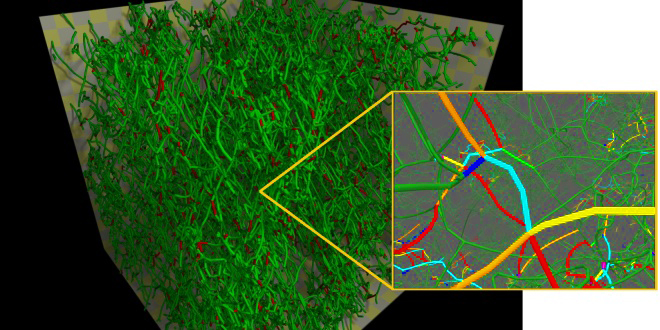Meijie Tang
Methods: Dislocation Dynamics
These pictures were obtained from a dislocation dynamics simulation of plastic flow in a Mo model system using the newly developed parallel ParaDiS code. The simulation was done on the ASC White and Thunder supercomputers. The simulation has reached more than a couple of percent in strain. It has been instrumental in the discovery by the ParaDiS team of a new type of dislocation microstructure: the dislocation multi-junction. The picture on the right shows a multi-junction formed by 4 dislocation lines with different Burgers vectors (represented by red, orange, yellow, blue respectively). Further studies show that these multi-junctions are unlike the conventional junctions formed by two dislocation line interactions, and they present much larger resistance to plastic flow. The multi-junctions have recently been confirmed by TEM observations in lab experiments by Hsiung (LLNL). Massive dislocation dynamics simulations also show that the multi-junctions can cause ultra strain hardening for deformation in certain crystallographic directions in BCC metals.
The single crystal plastic behavior of bcc metals (Tantalum as a prototype) has been simulated using our dislocation dynamics (DD) code. One of the key input to the DD simulation is the dislocation mobilities. For bcc metals, the screw dislocations are known to control the plastic deformation process. They move by a thermally activated kink pair mechanism and the activation enthalpy dominates the mobility of the screw dislocations. The activation enthalpy has been empirically fitted to experimental data for Ta using the Kocks-Argon-Ashby model. It has also been calculated by atomistic calculations using MGPT potentials, in particular at high pressures. The kink pair mechanism affects the yield properties as well as the strain hardening properties. The strain hardening is simulated by the dislocation junction mechanism. An averaged junction strength parameter has been obtained from experiments. The strain hardening behavior of bcc metals with kink pair mechanism is found to be different from that of fcc metals. It is shown that the forest hardening in bcc is made of two contributions, a free-length effect that logarithmically depend on the length of the mobile screw segments and a line tension effect linearly proportional to the dislocation obstalce density. Both terms depend on strain rate and temperature strongly. One main thrust of the DD simulations for bcc metals is to link with single dislocation properties calculated at the atomistic level such as the Peierls stress and activation enthalpy, in particular for the study of plastic deformation at high pressures and other extreme conditions. In addition, the DD simulation code has been coupled with a finite element method to account for boundary conditions more rigorously. It allows one to deal with surface effects and inhomogeneous loadings. The application of the coupled code is mainly for thin films or other structures at smaller length scales.
Selected Publications
- M. Tang, L. P. Kubin, G. R. Canova, "Dislocation mobility and the mechanical response of bcc (Ta) single crystals: a mesoscopic approach
 ", Acta Mater. 46, 3221 (1998).
", Acta Mater. 46, 3221 (1998). - M. Tang, B. Devincre, L. P. Kubin, "Simulation and modeling of forest hardening in BCC crystals at low temperatures
 ", Modeling Simul. Mater. Sci. Engi. 7, 893 (1999).
", Modeling Simul. Mater. Sci. Engi. 7, 893 (1999). - M. Tang, M. Fivel, L. P. Kubin, "From forest hardening to strain hardening in body centered cubic single crystals: simulation and modeling
 ", Materials Science and Engineering A 309-310, 256 (2001).
", Materials Science and Engineering A 309-310, 256 (2001).
Maintained by metals-alloys-web [at] llnl.gov (Lorin X. Benedict)





